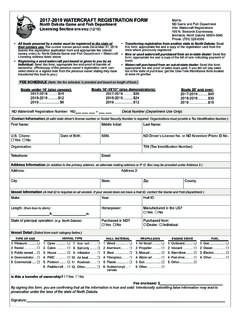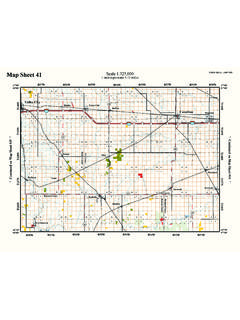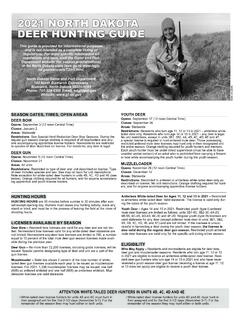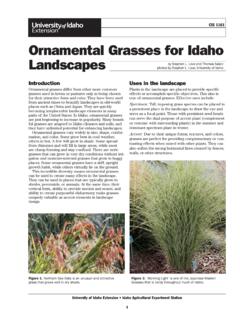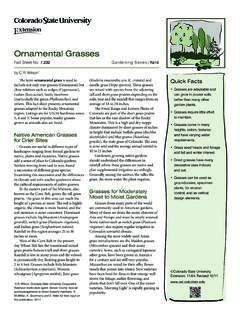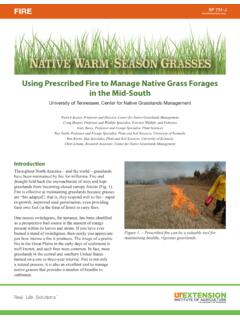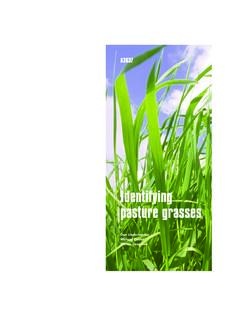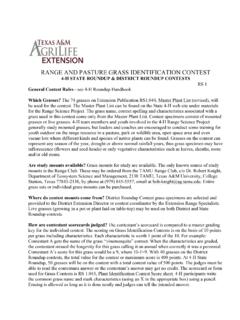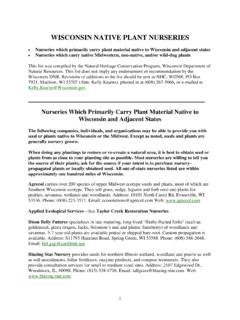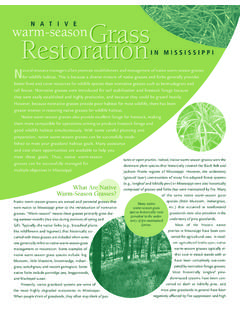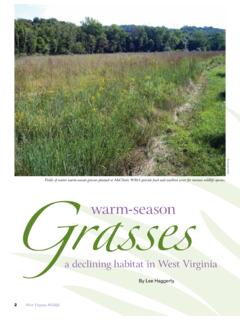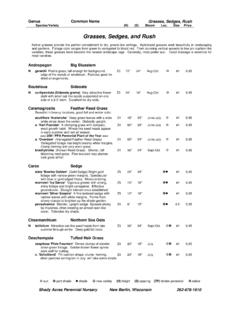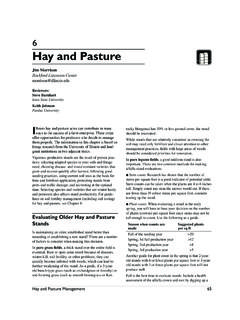Transcription of Prairie Wildflowers and Grasses - North Dakota
1 PrairieWildf lowersand GrassesNORTH Dakota GAME AND FISH DEPARTMENTOF North DAKOTAI ntroductionPrairies, or grasslands, in North Dakota and throughout the Great Plains have been gaining public interest over the last couple decades as more people became aware of their decline. Before the 1870s, prairies covered more than a third of the United States and almost all of North Dakota . What once was a mosaic of Grasses and forbs (fl owering plants) where buff alo roamed is now predominately agricultural land. With the arrival of increasing numbers of settlers in the late 1800s, the landscape started to change and continued to such a great extent that very little of diversity and distribution of Prairie grass and forbs are of great concern, but it s not just the plants that have suff ered.
2 Grasslands not only provide primary nesting habitat for a variety of bird species, but also are important staging and feeding areas for waterfowl and shorebirds during long migratory fl ights. In addition, prairies provide an important food source for small mammals and insects, which in turn support larger wild-life species. From a human standpoint, prairies can help to maintain clean air and water, control erosion, provide rich soil, are rich in history and folklore, and provide community income as a result of wildlife related recreation and tourism. All this combined makes it easy to see why prairies are now considered to be the most endangered , North Dakota was predominantly mixed-grass Prairie in the southwest and tallgrass in the northeast.
3 As the total annual precipitation increases eastward across the state, conditions allowed for taller, more robust Grasses . Today some of the best places to fi nd Prairie plants in North Dakota are federal grassland refuges, state-owned land, railway right-of-ways, ditches, old cemeteries, and pastures on private property through-out the Missouri Coteau in central and western parts of the Decline in North DakotaA combination of factors are to blame for this loss. Large-scale agriculture is a major factor, but fi re suppression, introduction of exotic species, altered hydrology and devel-opment also to Know Your Prairie Wildflowers and GrassesThis guide is intended to provide beginners with an overview of North Dakota s Prairie wildfl owers and Grasses .
4 It is by no means an exclusive list, but it outlines many of the common Prairie species in the state. It is not a scientifi c key, but does include descriptive clues for identifi cation and other interesting facts. The fl owers have been arranged into three primary groups based on when they bloom. The Grasses follow at the end. We hope the guide will help you identify Prairie wildfl ower and grass species and foster an appreciation of why it is important to continue conservation and restora-tion eff orts of prairies in North to identify Prairie plants can be rewarding.
5 This guide will get you started on more than 50 species. Since there are hundreds of Prairie plants in North Dakota , there are a couple of publications which can provide you with a more in-depth study. They are: wildfl owers of the Northern Great Plains by Vance, Jowsey and McLean (ISBN #: 0-8166-1351-6) and Grassland Plants of South Dakota and the Northern Great Plains by James R. Johnson and Gary E. Larson (ISBN # 0-913062-06-5). Both of these guides are excellent publications for North Dakota wildfl owers .. 1 Prairie Crocus .. 1 Breadroot .. 1 White Penstemon.
6 2 Shell Leaf Penstemon .. 2 Slender Penstemon .. 3 Downy Paintbrush .. 3 Western Wallfl ower .. 4 Ball Cactus .. 4 Prairie Smoke .. 5 Smooth 5 Wild Blue Flax .. 6 Two-Grooved Vetch .. 6 Summer wildfl owers .. 7 Prairie Rose .. 7 Purple Conefl ower .. 7 Prairie Lily .. 8 Purple Prairie Clover .. 8 Prairie Conefl ower .. 9 Common Yarrow .. 9 Blanket Flower ..10 Black-Eyed Susan ..10 Gumbo Lily ..11 Scarlet Globemallow ..11 Maximilian Sunfl ower ..12 Yucca ..12 Harebell ..13 Spiderwort ..13 Picklypear Cactus ..14 Silverleaf Scurfpea ..14 Meadow Anemone ..15 Scarlet Gaura.
7 15 Late-Summer wildfl owers ..16 Dotted Blazing Star ..16 Wild Bergamot ..16 Leadplant ..17 Goldenrod ..17 Showy Milkweed ..18 Tenpetal Blazingstar ..18 Rocky Mountain Bee-Plant ..19 Wild Licorice ..19 Lavender Hyssop ..20 Curlycup Gumweed ..20 Native Grass Species ..21 Big Bluestem ..21 Little Bluestem ..21 Indiangrass ..22 Sideoats Grama ..22 Blue Grama ..23 Junegrass ..23 Green Needlegrass ..24 Switchgrass ..24 Western Wheatgrass ..25 Reed Canary ..25 Foxtail Barley ..26 Porcupine Grass ..26 Tame Grass Species .. 27 Smooth Bromegrass ..27 Kentucky Bluegrass ..27 Table of ContentsTable of ContentsPrairie Crocus(Anemone patens)Distribution: StatewideHabitat: Undisturbed prairiesFlowers: 5 - 7 veined petals, pale blue or mauve in color, occasionally white or light yellowHeight: About 4 inchesBlooms: Mid-April to mid-May (earli-est Prairie fl ower)Family name: Buttercup (Ranuncu-laceae)Other names: Pasque fl ower, wild crocus, wind fl ower, or May fl owerPlant uses and other interesting facts.
8 Dakota Indians gave this fl ower special power, as they believed its song encouraged other plants to (Psoralea esculenta)Distribution: StatewideHabitat: Dry Prairie hillsidesFlowers: Light, bluish purple in color, fades with age, fl owers are arranged on short, dense stalks, leaves are hairy, 5 per stalkHeight: 5 - 9 inchesBlooms: May to early JuneFamily name: Legume (Fabaceae)Other names: Prairie turnipPlant uses and other interesting facts: Plains Indians used the starchy, tuberous root as a staple in their of Contents1 White Penstemon(Penstemon albius)Distribution: StatewideHabitat: Upland prairies, ditches and pasturesFlowers: White or pale purple in color, funnel shapedHeight: 6 - 16 inchesBlooms: Mid - May to late JuneFamily name: Figwort (Scrophulari-aceae)Other names: White beardtonguePlant uses and other interesting facts: Root can be chewed to ease toothaches.
9 Penstemon refers to its 5 stamens per fl Leaf Penstemon(Penstemon grandifl orus)Distribution: West of the Missouri River and the counties bordering the river on the eastHabitat: Upland prairies, road cuts, BadlandsFlowers: Pink to lavender in color, two lipped, bell-shapedHeight: 12 - 28 inchesBlooms: Late May to end of JuneFamily name: Figwort (Scrophulari-aceae)Other names: Pink beardtonguePlant uses and other interesting facts: Shell leaf penstemon is fair forage, best liked by deer, sheep and pronghorns. It has high reclamation Penstemon(Penstemon gracilis)Distribution: StatewideHabitat: Prairies and roadsidesFlowers: Pale lavender, refl ex lobes (not fl aring)Height: 8 - 20 inchesBlooms: Late May to late JuneFamily name: Figwort (Scrophulari-aceae)Other names: Slender beardtonguePlant uses and other interesting facts: The slender penstemon has smaller fl owers and thinner stems than the shell leaf Paintbrush(Castilleja acuminata)Distribution: StatewideHabitat: Open rocky Prairie hillsidesFlowers.
10 Yellowish to purplish in color, long slender gently arched pet-als are sometimes pink tippedHeight: 4 - 12 inchesBlooms: Late May to late JuneFamily name: Figwort (Scrophulari-aceae)Other names: Yellow Indian paint-brushPlant uses and other interesting facts: Downy paintbrush is a hemi-parasite, meaning it wraps its own roots around neighboring plants and takes Wallfl ower(Erysimun asperum)Distribution: Common statewideHabitat: Upland prairies and ditchesFlowers: Pale yellow in color, with 4 bright petals up to 1 inch long, fl ow-ers cluster at the end of each stalkHeight: 8 - 27 inchesBlooms: Late May to late JuneFamily name: Mustard (Brassicaceae)Plant uses and other interesting facts: Lakota Indians used the entire plant either in tea or chewed it to treat stomach and bowel Cactus(Coryphantha vivipara)Distribution: Statewide, except extreme east and northeastHabitat: Dry, sandy, rocky Prairie , road ditches, and south facing slopesFlowers: Purple in color, fairly large and has many petalsHeight: 1 - 2 inchesBlooms.

